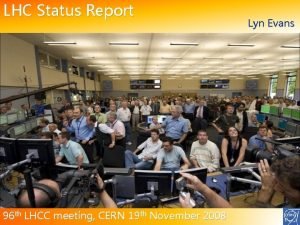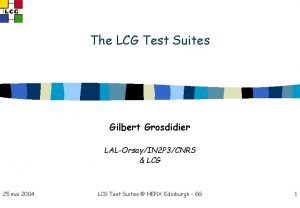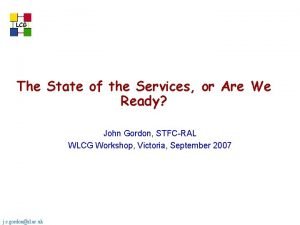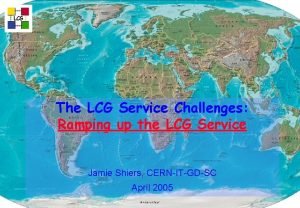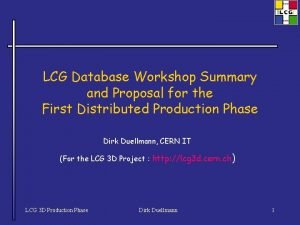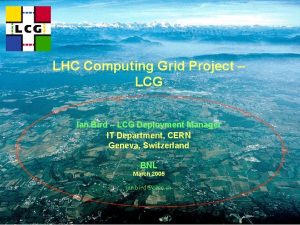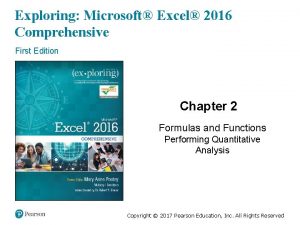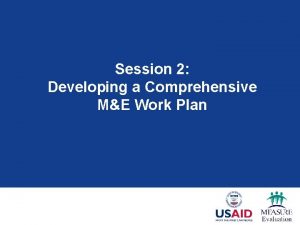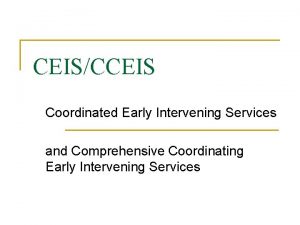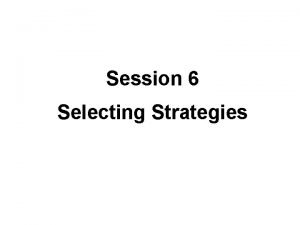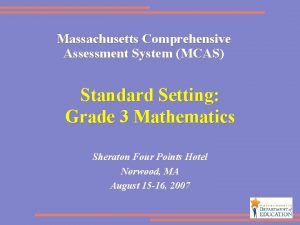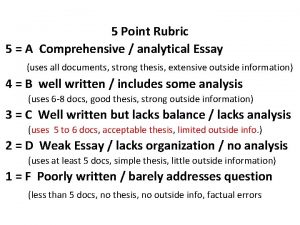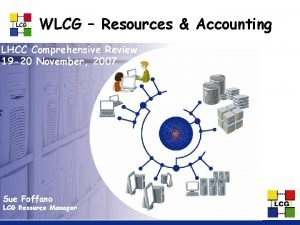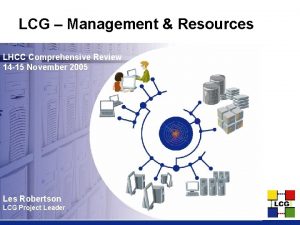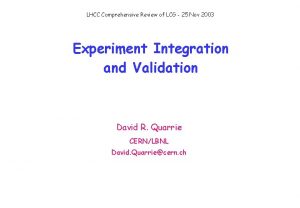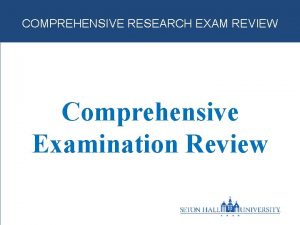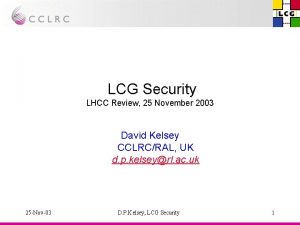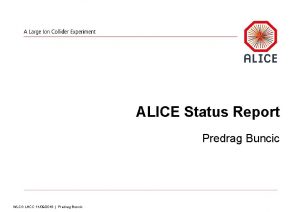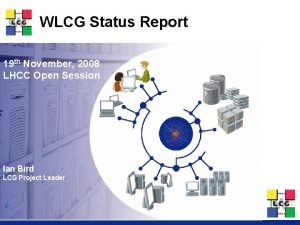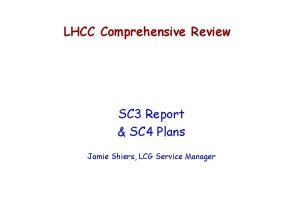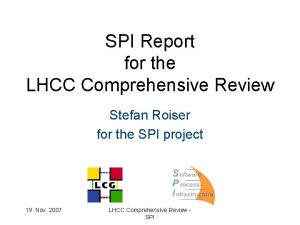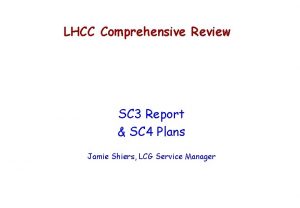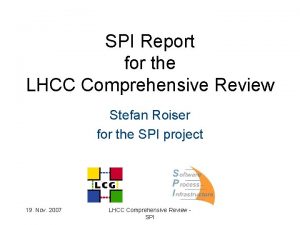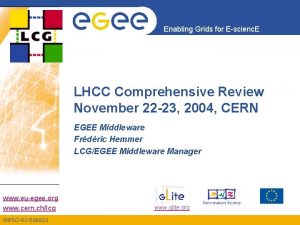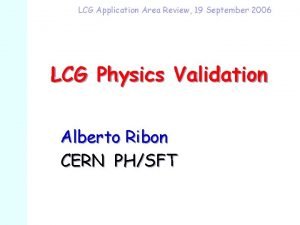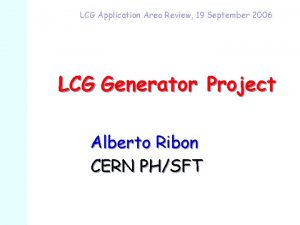LCG WLCG Overview LHCC Comprehensive Review 19 20



























- Slides: 27

LCG WLCG – Overview LHCC Comprehensive Review 19 -20 November, 2007 Les Robertson LCG Project Leader

No LCG Organisation – Phase 2 LHC Committee - LHCC Scientific Review cha Computing Resources Review Board - C-RRB Funding Agencies Collaboration Board – CB Experiments and Regional Centres Overview Board - OB Management Board - MB Management of the Project Architects Forum Grid Deployment Board Coordination of Common Applications Physics Applications Software Activity Areas Coordination of Grid Operation Distributed Analysis & Grid Support Grid Deployment Computing Fabric ng es

Applications Area Progress Summary LCG The organization of the Applications Area is mature and works reasonable well The main emphasis for the area has been consolidation and getting as stable as possible for the startup of LHC Regular production releases – ROOT, Geant 4, CORAL, POOL, Cool each with many improvements including performance and some new functionality The new organization of the MC Generator services has been put in place and a new repository structure has been introduced, as agreed with the community Introduced the Applications Area nightly build system to help in the integration and validation of new releases – and several complete configurations have been released with strong emphasis on consolidation and stability Improving coordination of software releases with other areas (middleware, fabric), and adding support for other significant platforms such as 64 -bit Scientific Linux and Mac. OSX/Intel les. robertson@cern. ch 3 3

ARDA LCG Ganga – ATLAS and LHCb exposed to users Lot of effort in training and support Good feedback and a lot of users! Dashboards & monitoring In production for all 4 experiments General core Specialised plug-in (CMS and ATLAS) VO information (global figures) User info (tracking of individual users jobs) Site info (breakdown of errors and efficiency figures) Experiment-specific support Participation in xrootd support for ALICE Distributed analysis coordination for ATLAS les. robertson@cern. ch 4

LCG Monitor of the production system Site info per VO Tracking of users' jobs les. robertson@cern. ch 5

Baseline Services LCG The Basic Baseline Services – from the TDR (2005) Storage Element Castor, d. Cache, DPM (with SRM 1. 1) Storm added in 2007 SRM 2. 2 – long delays incurred - being deployed in production Globus/Condor-C web services (CREAM) Basic transfer tools – Gridftp, . . File Transfer Service (FTS) LCG File Catalog (LFC) LCG data mgt tools - lcg-utils Posix I/O – Grid File Access Library (GFAL) Synchronised databases T 0 T 1 s 3 D project les. robertson@cern. ch Information System Compute Elements 6 g. Lite. . . c. Workload Management ontinu ingatev. CERN r eliin abproduction olutio ility, p n VO Management erf. System o r mance functi (VOMS) , onalit y, requir VO Boxes emen t Application softwares installation Job Monitoring Tools

Data & Storage Services LCG At the time of the last review there was concern over the storage management services, in particular: Implementation of the new version of the Storage Resource Manager (SRM 2. 2) SRM is a standard interface to the storage management systems WLCG spec/usage agreed May 2006, but details finally agreed only in November 2006 The performance and stability of CASTOR 2 needs to be improved for both the Tier-0 and Tier-1 sites les. robertson@cern. ch 7

Data & Storage Services LCG d. Cache (DESY, FNAL) New version being deployed now with all functionality needed for start-up (including SRM 2. 2) In production at NDGF (end October) and FZK (second week of November) CASTOR (CERN) Performance problems at CERN resolved; full performance demonstrated with ATLAS New version (SRM 2. 2 -ready) deployed at all Castor sites over past few months Upgrades with all the functionality needed for start-up is being deployed now DPM (CERN), STORM (INFN) “simpler” disk-only systems for Tier-2 s Being introduced in production les. robertson@cern. ch 8

SRM 2. 2 Deployment LCG • • First implementations available around the end of 2006 GSSD – working group of sites and developers formed to guide deployment Many problems encountered – but basic tests finally passed and test instances installed at several sites in July Priority/availability problems at developer sites test programme stalled during the summer more realistic schedule agreed at WLCG workshop early September SRM 2. 2 now in production: • d. Cache - 2 nd week of November at FZK • Castor – end October at CERN, 3 rd week of November at CNAF (SRM 1. 1 and SRM 2. 2 can co-exist at CASTOR sites) Comprehensive testing using packaged tests – but only LHCb has tested SRM 2. 2 functionality with experiment applications Target is to have SRM 2. 2 in production (d. Cache. Castor) at all Tier-1 s by end of year, key Tier-2 sites by February 2008 DPM, STORM already available for production use les. robertson@cern. ch 9

LCG les. robertson@cern. ch 10

LCG les. robertson@cern. ch 11

Load Tests for CMS We have designed a Load. Test infrastructure to execute 24/7 transfer tests between sites. The test have been running continuously for some months. Rates have increased since CSA 06 last fall and more sites are participating. T 0 --> T 1 and many regional T 1 <--> T 2 transfers are reliable. Issues with non-regional T 1<--> T 2 which are not easy to debug and there are many combinations to test. A program has started to address this issue. May require additional manpower. CSA 06 Sep. 07 October 31, 2007 M. Kasemann Grid. Camp 2007: CMS Computing Overview 12/28

Data Distribution from CERN LCG Target 2008 jan feb mar apr may jun jul aug sep oct Data distribution from CERN to Tier-1 sites The target rate was achieved last year under test conditions This year under more realistic experiment testing, reaching target peak rate with ATLAS and CMS active les. robertson@cern. ch 13

LCG Castor during CMS Export Tests CMS t 0 export pool (330 TB across 60 servers) Red: Data into the pool • ~100 MB/s from tape • up to 100 MB/s data import • rest is data written by CSA 07 preparation application. Green: Data out of the pool • ~280 MB/s to tape • up to 100 MB/s data export • rest is data read by CSA 07 preparation application. CSA 07 starts • Several concurrent activities with aggregate I/O corresponding to nominal CMS speed at 100% accelerator efficiency. • Up to 900, 000 file operations/day (10/s) • Good stability 23 -Oct-07 Tony Cass cern/it – 514 october 07 les. robertson@cern. ch

LCG Grid Activity Continuing increase in usage of the EGEE and OSG grids All sites reporting accounting data (CERN, Tier-1, -2, -3) Increase in past 17 months – 5 X number of jobs - 3. 5 X cpu usage 100 K jobs/day 23 -Oct-07 15 les. robertson@cern. ch

LCG Tier-2 Sites – October 2007 23 -Oct-07 30 sites deliver 75% of the cpu 30 sites deliver 1% 16 les. robertson@cern. ch

October 2007 - CPU Usage CERN, Tier-1 s, Tier-2 s LCG * * NDGF usage for September 2007 23 -Oct-07 > 85% of CPU Usage is external to CERN 17 les. robertson@cern. ch

LCG Site Reliability – CERN + Tier-1 s “Site Reliability” a function of grid services middleware site operations storage management systems networks. . . . Targets – CERN + Tier-1 s les. robertson@cern. ch Before July 07 Dec 07 Avg. last 3 months Each site 88% 91% 93% 89% 8 best sites 88% 93% 95% 93% 18

LCG Tier-2 Site Reliability Tier-2 Sites 83 Tier-2 sites being monitored les. robertson@cern. ch 19

LCG Improving Reliability Monitoring Metrics Workshops Data challenges Experience Systematic problem analysis Priority from software developers les. robertson@cern. ch 20

LCG lan ployment p e d w e n d ign an d – re-des Suspende mented y imple g te a tr s k c llba Fa les. robertson@cern. ch 21

Done LCG Level 1 Milestones Only 5 sites have tested their 24 X 7 support, and only 4 have put the support into operation les. robertson@cern. ch Late <1 mon >1 mon colour coding Only 3 sites have completed the set of VO BOX milestones 22

Testing Integration with DAQ LCG ALICE Major test programme over several years Full data rate demonstrated LHCb On-going tests, full data rate demonstrated ATLAS Exercised during Muons tests (M 4, M 5) ~50% of full data rate CMS First tests scheduled January 2008 les. robertson@cern. ch 23

LCG Combined Computing Readiness Challenge - CCRC A combined challenge by all Experiments & Sites validate the readiness of the WLCG computing infrastructure before start of data taking at a scale comparable to that need for data taking in 2008 Should be done well in advance of the start of data taking to identify flaws, bottlenecks and allow time to fix them Wide battery of tests – simultaneously – all experiments Driven from DAQ with full Tier-0 processing Site-site data transfers, storage system to storage system Required functionality and performance Data access patterns similar to 2008 processing CPU and data loads simulated as required to reach 2008 scale Coordination team in place Two test periods – February, May les. robertson@cern. ch 24

Ramp-up Needed for Startup LCG 2. 9 X 3 X 3. 7 X Sep -06 Jul -07 Apr -08 Sep -06 2. 3 X Sep -06 Jul -07 les. robertson@cern. ch Jul -07 Apr -08 Jul -07 3. 7 X Apr -08 Sep -06 pledge Jul -07 Sep -07 Apr -08 target usage Apr -08 25

LCG Grid Infrastructure Outlook WLCG uses two major science grid infrastructures: OSG – current funding cycle goes to the end of 2010 EGEE – current funding stops April 2008 proposal to extend to March 2010 – expect acceptance, but possibly with major cut in software support EGI-DS - Design project under way since September to propose a long-term follow-on infrastructure This would be based on formal National Grid Infrastructures, many of which have not yet been formed Too early to guess what will be proposed, whether it will provide the underlying operational support needed for WLCG But time is short to formulate a project that could be operational by April 2010 Time now to look at fall-back strategies les. robertson@cern. ch 26

Summary LCG Applications support in good shape WLCG service Baseline services in production with the exception of SRM 2. 2 Continuously increasing capacity and workload General site reliability is improving – but still a concern Data and storage remain the weak points Experiment testing progressing – involving now most sites, approaching full dress rehearsals Sites & experiments working well together to tackle the problems Major Combined Computing Readiness Challenge next year before the machine starts, -- essential to provide experience for site operations and storage systems – stressed simultaneously by all four experiments Steep ramp-up ahead to deliver the capacity needed for 2008 run les. robertson@cern. ch 27
 Lhcc cern
Lhcc cern Lcg webcast
Lcg webcast Lcg random
Lcg random Lcg test
Lcg test Lcg
Lcg Buaa vpn
Buaa vpn Lcg
Lcg Lcg database
Lcg database Lcg projects
Lcg projects Narrative review vs systematic review
Narrative review vs systematic review Chapter review motion part a vocabulary review answer key
Chapter review motion part a vocabulary review answer key Narrative review vs systematic review
Narrative review vs systematic review Uncontrollable spending ap gov
Uncontrollable spending ap gov Nader amin-salehi
Nader amin-salehi Exploring microsoft office excel 2016 comprehensive
Exploring microsoft office excel 2016 comprehensive Segev shalom comprehensive high school israel
Segev shalom comprehensive high school israel Comprehensive work plan
Comprehensive work plan Heading of statement of comprehensive income
Heading of statement of comprehensive income Comprehensive od interventions
Comprehensive od interventions Coordinated early intervening services
Coordinated early intervening services Carlton comprehensive high school calendar
Carlton comprehensive high school calendar Comprehensive thinking
Comprehensive thinking Efsa comprehensive european food consumption database
Efsa comprehensive european food consumption database Body: massachusetts comprehensive assessment system
Body: massachusetts comprehensive assessment system Comprehensive primary health care definition
Comprehensive primary health care definition Comprehensive model of personalised care
Comprehensive model of personalised care Conclusion of continuous and comprehensive evaluation
Conclusion of continuous and comprehensive evaluation Sample rubrics for essay 5 points
Sample rubrics for essay 5 points
